Individual Economists
"And May All Your Christmases Be [Woke]": Liberal Pundits Come For Santa And Other Holiday Traditions
“And may all your Christmases be [woke].”
As Santa prepares for his harrowing journey around the world, he is being closely pursued by liberal commentators protesting his race, gender, and capitalist leanings.
The perpetually outraged have finally come for Christmas.
One columnist at Slate called for Santa to be replaced by a penguin due to his race.
Aisha Harris admitted that she was being a bit cheeky in pushing the penguin substitute but sought to express “my real concern that America continues to promote the harmful idea of whiteness-as-default.”
Back to Santa. The British Brighton and Hove Museums have been the focus of this debate over the reposting of an earlier column by the museum’s Joint Head of Culture Change, Simone LaCorbinière, who explained that the traditional Christmas simply will not do with a Santa who is “too white, male” and a colonizer of elves.
I suppose that when you use public dollars to hire someone who will serve as “Joint Head of Culture Change,” it was only a matter of time before they came for Christmas. After all, the idea is that the British culture must generally change, right?
In a 2023 column titled Decolonising Father Christmas, LaCorbinière warns that Santa is “too white, male” and the traditional story “presents Santa as the ultimate authority of all societies. This asks us to accept colonial assumptions of cultural superiority. It doesn’t recognise the complex realities colonised people face.”
She expresses horror at the fact that Santa is “an old white man [who] supervise[s] the elves’ work.” We can put aside that Santa was identified in “A Visit from St. Nicholas” (1823) as a “chubby and plump, a right jolly old elf.” LaCorbinière portrays him as a heartless white capitalist living off the labor of a captive elf workforce. She calls for “Santa to work in the factory alongside the elves.”
Changes must be made, according to the museum, to decolonize Christmas and break away from holiday images that are “white, male and non-disabled”:
“This perpetuates the harmful ‘colonial gaze’. Non-Western cultures are ‘othered’. It says that the coloniser has the power to judge all people. And it ignores many communities’ histories and traditions. Telling the story like this teaches new generations that the coloniser knows best.”
Santa is not alone.
In the meantime, NPR noted White Christmas has racist undertones, while Joy Reid has declared Jingle Bells to be a racist song.
Even “It’s a Wonderful Life” is a “bigoted” story fed to the populace to reinforce capitalist and racist values. Professor James Deaville warned recently that “while some viewers see the ending as affirming community, the film also keeps George partly ignorant of how the forces of inequity are actually operating in his largely white community.”
They are the self-flagellants of the holidays, moving through Christmas markets (which are also fascist traditions) with Gregorian chants of guilt. Here are some enlightened carolers seen recently spreading “Tidings of Great Joy [Reid]” for the holiday:
Clearly there are many liberals who still enjoy the holidays without the need for self-affirming declarations of outrage or disgust.
However, for some on the left, there is little joy in Christmas without identity politics and white guilt.
So the more the merrier and, as Tiny Tim declared, “God bless us, every one!”
Tyler Durden Thu, 12/25/2025 - 08:10White House Orders Venezuelan Oil "Quarantine" As Gunboat Diplomacy Drives Dark Fleet Tanker Into Atlantic
The Trump administration has ordered the U.S. military to enforce a two-month "quarantine" of Venezuelan oil, signaling an intensification of gunboat diplomacy aimed at fostering regime instability in Caracas, with potential spillover effects that could ripple across the Caribbean into Cuba.
"While military options still exist, the focus is to first use economic pressure by enforcing sanctions to reach the outcome the White House is looking (for)," a U.S. official told Reuters on Wednesday afternoon, speaking on condition of anonymity.
The U.S. Coast Guard has already intercepted two Venezuelan crude tankers this month and is prepared to seize another dark fleet tanker, but the vessel Bella-1 was chased away.
Sources familiar with the sanctioned Bella-1 told Bloomberg that the tanker retreated into the Atlantic after being pursued by U.S. Coast Guard forces. The tanker failed to comply with instructions to move to calmer waters for boarding.
Bella-1's decision to evade closely monitored Venezuelan waters underscores how the Trump administration's U.S. blockade, widely viewed as gunboat diplomacy, has already disrupted Venezuela–Cuba–China oil flows. The blockade is set to further tighten financial pressure on President Nicolás Maduro's government by constraining crucial oil revenues. Beijing has already condemned Trump's gunboat diplomacy.
According to analytics firm Kpler, Caracas has shipped nearly 900,000 barrels per day this year and relies on 400 dark-fleet tankers to transport the crude, much of which is bound for China.
"The efforts so far have put tremendous pressure on Maduro, and the belief is that by late January, Venezuela will be facing an economic calamity unless it agrees to make significant concessions to the U.S," the U.S. official told Reuters.
Also reported this week, the Trump administration continues to expand its large military presence in the Caribbean, with more than 15,000 troops, an aircraft carrier, multiple warships, and stealth fighters staged across the region.
As we have repeatedly noted, this all reflects a significant reposturing of the U.S. military toward so-called Western hemispheric defense, effectively a Monroe Doctrine 2.0.
Tyler Durden Thu, 12/25/2025 - 07:50The Economics Of Santa Claus
Authored by Vincent Cook via The Mises Institute,
When I was a junior at a high school in the suburbs of Los Angeles in late 1978, rather uncharacteristically, I took a big risk. The teacher of my American Government class, Mr. Knapp, gave us an assignment to write a serious paper about government economic policy. Instead of doing that, I decided to submit a paper with a satirical theme, estimating what it would cost to become Santa Claus. Not only was I not following instructions, I had no idea how Mr. Knapp would react to my brand of humor.
As you read the transcription of my paper below, bear in mind that I wrote it a few years before I learned anything about libertarianism or about Austrian economics. Still, I was under the influence of the libertarian zeitgeist prevailing in California at the time. With inflation raging out of control while traditional statist authority figures in both major parties were lamely touting yet more business-as-usual interventions and tax increases, Californians had had enough by then. In November of 1978, they revolted against property taxes (led by the legendary anti-tax gadfly Howard Jarvis, passing the Proposition 13 voter initiative to amend the state constitution) and even gave a libertarian candidate for governor 5.5 percent of the vote. Reading this work of mine, I’m sure you’ll agree that there was a definite proto-Austro-libertarian influence at work.
Keep in mind too that the purchasing power of the dollar in 1978 was at least a factor of ten times greater than it is today, and, of course, the American population has increased a great deal too, so you might find my cost estimates absurdly low. They weren’t low at the time, however. Also be mindful that there was neither an internet nor privacy-unfriendly smart phone service, and personal computers had only just been introduced into the marketplace (in fact, my part-time retail job responsibilities at Radio Shack the previous summer included sales of the primitive TRS-80 computer), so you’ll have to pardon the technological backwardness of my cost analysis in the information category—that part of Santa’s job could probably be done much more cheaply these days.
I have added screenshots of my paper showing a couple of Mr. Knapp’s comments.
Figure 1: Important Question Posed by Mr. Knapp
Source: Vincent Cook
Figure 2: Mr. Knapp’s Overall Comment
I’m taking another big risk to spring my youthful joke on you nearly five decades later, hoping that you’ll enjoy it as much as Mr. Knapp did back then—Merry Christmas!
Economics of Santa ClausHow often have you heard that there is no Santa Claus? If you check your history books, there was a real St. Nicholas who gave gifts to children, and he was given the Santa Claus title. Suppose someone wanted to claim this title now. How much would it cost? (I will restrict this Santa to the United States.)
To examine this profound question, I will break down the cost analysis into the three major categories which Santa is expected to fulfill.
1) Manufacture of 220 million gifts. These must be elf-handcrafted, at a factory at the North Pole.
2) Distribution of 220 million gifts. Local distribution takes place during about 5 hours on Christmas Eve by assistant Santa’s with 12 reindeer sleighs.
3) Monitoring of 220 million people, to determine how good they are.
For the first category, I will assume that an elf is a special sub-culture of human beings.
An elf should be able to turn out one hand-crafted gift a day. Since working conditions at the pole are very difficult, Santa will be expected to provide room and board, plus a salary of $200 per day. 220 million gifts then would require 220 million elf-days of labor at $200 per elf-day, at a total cost of $44 billion. Assuming continuous use of facilities, a city would be needed to house 600,000 elves. At the North Pole, this would be very expensive, say $1,000 per elf per day. This would bring the cost of facilities to $219 billion per year. Assuming the materials for each gift cost an average of $30, including transport to the pole, then the materials cost would be roughly $7 billion. Finally, we have the cost of the factories themselves; which, given the transient nature of the arctic ice cap, might cost $60 billion per year.
We see that arctic manufacturing is very expensive, I estimate the sub-total for this category to be $330 billion each year.
The second category is distribution.
This can be further divided into primary distribution (from North Pole to local distribution centers) and Christmas Eve local distribution (from local centers by sleigh to living rooms of families).
For the primary distribution, airlifting goods from the North Pole to the Canadian railroad network would be needed. This would probably cost about $10 billion. Further distribution and storage would also cost about $10 billion.
For Christmas Eve, assuming a sleigh crew of 3 men could handle 20 households, a fleet of 3 million sleighs, 36 million reindeer, and 90 million man-hours of labor would be needed. Assuming $500 a year for maintenance, the sleigh fleet would need $1.5 billion, plus another $0.5 billion for storage. Each reindeer would probably cost $1000 a year, for a total of $36 billion. 90 million man-hours, at $10 per man-hour, would cost about $1 billion. An additional $1 billion would be needed to cover the cost of legal expenses involved for employees caught trespassing while delivering gifts.
The sub-total for this category is about $60 billion.
The third category of Santa’s activities is in checking up on people to see who is good and who isn’t, to determine who deserves the best gifts.
The best method would be to hire a detective to monitor listening equipment at homes, workplaces, and schools. A single Santa detective could probably monitor 20 people, and write in-depth evaluations of them. For the United States, this would require 11 million detectives, plus a communications network, information storage and processing at the north pole, and equipment for the detectives. Since a full-time detective probably would cost $20,000 per year, total labor cost would be about $220 billion per year. Information evaluation, storage, and communications might cost $30 billion for 220 million reports. New equipment costs (such as “bugs,” mini microphones, transmitters, tape recorders, etc.) might run about $2 billion a year.
Sub-total for this category might be about $252 billion per year.
Adding up the three subtotals, we get a grand total for being a Santa Claus as $642 billion per year.
This is even more than the federal government spends, which shows how impractical it is to become a Santa Claus.
Still, there might be some potential income for Santa.
Huge sums of money could be extorted from people by the bad information that Santa’s detectives get.
Santa might also get to claim his 600,000 elves as dependents on his tax forms. His detectives could claim to be unemployed, and thus collect welfare and unemployment checks from the government. Santa could incorporate and collect royalties on the use of his image from corporations.
Best of all, Santa’s free gifts might drive corporations into bankruptcy, and he could take over all economic activity in the United States, with all of its potential for profit.
Santa could then proceed to take over the economies of many extremely rich nations, like Saudi Arabia and Iran, and thus assure himself of enough money to run his operations.
Tyler Durden Thu, 12/25/2025 - 07:0010 Christmas Day Reads
My jolly X-Mas Day reads:
• Santa might be Christmas’ main man, but Mrs. Claus would like a word: Don’t look now, but here comes Mrs. Claus, right down Santa Claus’ lane. While St. Nick might be the season’s marquee draw, Modrzejewski and others say Mrs. Claus’ popularity is on the rise as clients look to break from routine, enlist the character’s motherly qualities and highlight positive female role models. (USA Today)
• Societies with Little Money Are Among the Happiest on Earth: Wealth and well-being go together in many studies, but certain communities complicate this link. (Scientific American)
• Forget the Bond Vigilantes. It’s the Gold Vigilantes You Need to Worry About. The bond vigilantes, as first coined by Wall Street veteran Ed Yardeni, sniff out government largess, corporate profligacy, geopolitical tremors, and inflation risks long before other financial assets and respond in kind. And by the sheer brute force of its size, bond markets force both the subjects of its wrath, and the investors that rely on them, into submission. (Barron’s)
• Crypto for Christmas? Gen Z-ers Are Cautiously Open to the Idea. Despite recent volatility in the crypto market, younger generations are still open to receiving digital currencies as gifts. (New York Times)
• Is the Tao smarter than the Dow? A high-return investment hiding in plain sight. (The Leading Edge)
• How to create a home that appeals to all five senses: The way a couch feels matters as much as how it looks. (Washington Post) see also Scent Makes a Place: How the desert taught me to smell. (Nautilus)
• America’s Tiny Airports and the People Who Love Them: Small-airport devotees brag about cheap parking, minimal TSA waits and friendly employees. (Wall Street Journal)
• The Doomsday Glacier Is Getting Closer and Closer to Irreversible Collapse: An analysis of the expansion of cracks in the Thwaites Glacier over the past 20 years suggests that a total collapse could be only a matter of time. (Wired)
• The Truth Physics Can No Longer Ignore: The fundamental nature of living things challenges assumptions that physicists have held for centuries. (The Atlantic)
• Four Perspectives on Bing Crosby: We hear him sing “White Christmas” every December, but the most inspiring stories about Bing are hidden from view. (The Honest Broker)
Be sure to check out our Masters in Business interview this weekend with comedian Jay Leno, former Tonight Show host, and creator of Jay Leno’s Garage.
Which states contribute the most and least to federal revenue?
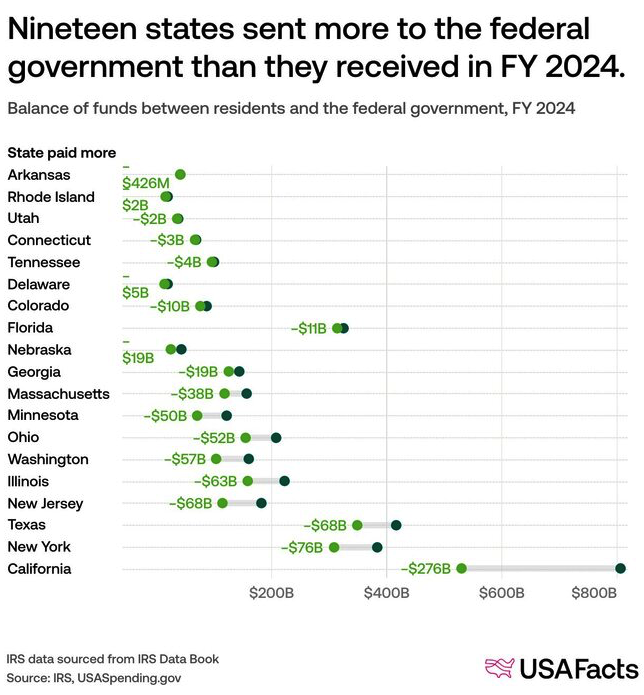
Source: USA Facts
Sign up for our reads-only mailing list here.
The post 10 Christmas Day Reads appeared first on The Big Picture.
If Jesus Were Born Today, Would He Survive The American Police State?
Authored by John & Nisha Whitehead via The Rurtherford Institute,
“When the song of the angels is stilled, when the star in the sky is gone, when the kings and princes are home, when the shepherds are back with their flocks, the work of Christmas begins: to find the lost, to heal the broken, to feed the hungry, to release the prisoner, to rebuild the nations, to bring peace among the people, to make music in the heart.”—Howard Thurman, theologian and civil rights activist
Every Christmas, Christians celebrate the birth of a child born into oppression—an occupied land, a climate of political fear, and a government quick to crush anything that threatened its authority.
Two thousand years later, the parallels are unmistakable.
If Jesus were born in modern America, under a government obsessed with surveillance, crackdowns on undocumented immigrants, religious nationalism, and absolute obedience to a head-of-state rather than the rule of law, would he survive long enough to preach about love, forgiveness and salvation? Would his message of peace, mercy, and resistance to empire be branded as extremism?
As familiar as the Christmas story of the baby born in a manger might be, it is also a cautionary tale for our age.
The Roman Empire, a police state in its own right, had ordered that a census be conducted. Joseph and his pregnant wife Mary traveled to the little town of Bethlehem so that they could be counted. There being no room for the couple at any of the inns, they stayed in a stable (a barn), where Mary gave birth to a baby boy, Jesus. Warned that the government planned to kill the baby, Jesus’ family fled with him to Egypt until it was safe to return to their native land.
Yet what if Jesus had been born 2,000 years later?
What if, instead of being born into the Roman police state, Jesus had been born at this moment in time? What kind of reception would Jesus and his family be given? Would we recognize the Christ child’s humanity, let alone his divinity? Would we treat him any differently than he was treated by the Roman Empire? If his family were forced to flee violence in their native country and sought refuge and asylum within our borders, what sanctuary would we offer them?
A singular number of churches across the country have asked those very questions in recent years, and their conclusions were depicted with unnerving accuracy by nativity scenes in which Jesus and his family are separated, segregated and caged in individual chain-link pens, topped by barbed wire fencing.
Those nativity scenes were a pointed attempt to remind the modern world that the narrative about the birth of Jesus is one that speaks on multiple fronts to a world that has allowed the life, teachings and crucifixion of Jesus to be drowned out by partisan politics, secularism, materialism and war, all driven by a manipulative shadow government called the Deep State.
The modern-day church has largely shied away from applying Jesus’ teachings to modern problems such as war, poverty, immigration, etc., but thankfully there have been individuals throughout history who ask themselves and the world: what would Jesus do?
What would Jesus—the baby born in Bethlehem who grew into an itinerant preacher and revolutionary activist, who not only died challenging the police state of his day (namely, the Roman Empire) but spent his adult life speaking truth to power, challenging the status quo of his day, and pushing back against the abuses of the Roman Empire—do about the injustices of our modern age?
Dietrich Bonhoeffer asked himself what Jesus would have done about the horrors perpetrated by Hitler and his assassins. The answer: Bonhoeffer was executed by Hitler for attempting to undermine the tyranny at the heart of Nazi Germany.
Aleksandr Solzhenitsyn asked himself what Jesus would have done about the soul-destroying gulags and labor camps of the Soviet Union. The answer: Solzhenitsyn found his voice and used it to speak out about government oppression and brutality.
Martin Luther King Jr. asked himself what Jesus would have done about America’s warmongering. The answer: declaring “my conscience leaves me no other choice,” King risked widespread condemnation as well as his life when he publicly opposed the Vietnam War on moral and economic grounds.
Their lives make clear that the question “What would Jesus do?” is never abstract. It is always political, always dangerous, and always costly.
Even now, there remains a disconnect in the modern church between the teachings of Christ and the suffering of what Jesus in Matthew 25 refers to as the “least of these.”
Yet this is not a theological gray area: Jesus was unequivocal about his views on many things, not the least of which was charity, compassion, war, tyranny and love.
After all, Jesus—the revered preacher, teacher, radical and prophet—was born into a police state not unlike the growing menace of the American police state.
Jesus was not born into comfort or security. He was born poor, without shelter, in an occupied land ruled by force and fear, under the watchful eye of a government obsessed with control, compliance, and the elimination of perceived threats. His parents were politically powerless. His birthplace was makeshift. His earliest days were shaped by fear of state violence.
Herod’s response to the news of the Messiah’s birth was not humility or reflection, but paranoia. Threatened by the mere possibility of a rival authority, Herod turned to brute force. The lesson is timeless: this is how tyranny operates. Unchecked power, when gripped by insecurity, will always seek to eliminate dissent rather than allow its own corruption to be confronted.
Modern governments, including our own, cloaked in the language of security and “law and order,” behave no differently. Any challenge to centralized power is treated as a threat to be neutralized. In such an environment, speaking truth to power is dangerous. Challenging imperial authority invites retaliation.
From the moment of his birth, Jesus represented a threat—not because he wielded violence or political power, but because his life and message exposed the moral bankruptcy of empire and offered an alternative rooted in justice, mercy, and truth.
When Jesus grew up, he had powerful, profound things to say—things that would change how we view people, things that challenged everything empire stood for. “Blessed are the merciful,” “Blessed are the peacemakers,” and “Love your enemies” are just a few examples of his most profound and revolutionary teachings.
When confronted by those in authority, Jesus did not shy away from speaking truth to power. Indeed, his teachings undermined the political and religious establishment of his day. It cost him his life. He was eventually crucified as a warning to others not to challenge the powers-that-be.
Can you imagine what Jesus’ life would have been like if, instead of being born into the Roman police state, he had been born and raised in the American police state?
Consider the following if you will.
Had Jesus been born in the era of the American police state, his parents would not have traveled to Bethlehem for a census. Instead, they would have been entered into a vast web of government databases—flagged, categorized, scored, and assessed by algorithms they could neither see nor challenge. What passes for a census today is no longer a simple headcount, but rather part of a data-harvesting regime that feeds artificial intelligence systems, predictive policing programs, immigration enforcement, and national security watchlists.
Instead of being born in a manger, Jesus might have been born at home. Rather than wise men and shepherds bringing gifts, however, the baby’s parents might have been forced to ward off visits from state social workers intent on prosecuting them for the home birth.
Had Jesus been born in a hospital, his blood and DNA would have been taken without his parents’ knowledge or consent and entered into a government biobank. While most states require newborn screening, a growing number are holding onto that genetic material long-term for research, analysis and purposes yet to be disclosed.
Had Jesus’ parents been undocumented immigrants, they and their newborn child might have been swept up in an early-morning ICE raid, detained without meaningful due process, processed through a profit-driven, private prison, and deported in the dead of night to a detention camp in a third-world country.
From the time he was old enough to attend school, Jesus would have been drilled in lessons of compliance and obedience to government authorities, while learning little—if anything—about his own rights. Had he been daring enough to speak out against injustice while still in school, he might have found himself tasered or beaten by a school resource officer, or at the very least suspended under a school zero tolerance policy that punishes minor infractions as harshly as more serious offenses.
Had Jesus disappeared for a few hours let alone days as a 12-year-old, his parents would have been handcuffed, arrested and jailed for parental negligence. Parents across the country have been arrested for far less “offenses” such as allowing their children to walk to the park unaccompanied and play in their front yard alone.
Rather than disappearing from the history books from his early teenaged years to adulthood, Jesus’ movements and personal data—including his biometrics—would have been documented, tracked, monitored and filed by governmental agencies and corporations such as Google and Microsoft. Incredibly, 95 percent of school districts share their student records with outside companies that are contracted to manage data, which they then use to market products to us.
From the moment Jesus made contact with an “extremist” such as John the Baptist, he would have been flagged for surveillance because of his association with a prominent activist, peaceful or otherwise. Since 9/11, the FBI has actively carried out surveillance and intelligence-gathering operations on a broad range of activist groups, from animal rights groups to poverty relief, anti-war groups and other such “extremist” organizations.
Jesus’ anti-government views would certainly have resulted in him being labeled a domestic extremist. Law enforcement agencies are being trained to recognize signs of anti-government extremism during interactions with potential extremists who share a “belief in the approaching collapse of government and the economy.”
While traveling from community to community, Jesus might have been reported to government officials as “suspicious” under the Department of Homeland Security’s “See Something, Say Something” programs. Many states are providing individuals with phone apps that allow them to take photos of suspicious activity and report them to their state Intelligence Center, where they are reviewed and forwarded to law-enforcement agencies.
Rather than being permitted to live as an itinerant preacher, Jesus might have found himself threatened with arrest for daring to live off the grid or sleeping outside. In fact, the number of cities that have resorted to criminalizing homelessness by enacting bans on camping, sleeping in vehicles, loitering and begging in public has doubled.
Jesus’ teachings—his refusal to pledge allegiance to empire, his warnings about wealth and power, his insistence that obedience to God sometimes requires resistance to unjust authority—would almost certainly be interpreted today as signs of ideological extremism. In an age when dissent is increasingly framed as a threat to public order, Jesus would not need to commit violence to be labeled dangerous. His words alone would suffice.
Viewed by the government as a dissident and a potential threat to its power, Jesus might have had government spies planted among his followers to monitor his activities, report on his movements, and entrap him into breaking the law. Such Judases today—called informants—often receive hefty paychecks from the government for their treachery.
Had Jesus used the internet to spread his radical message of peace and love, he might have found his blog posts infiltrated by government spies attempting to undermine his integrity, discredit him or plant incriminating information online about him. At the very least, he would have had his website hacked and his email monitored.
Had Jesus attempted to feed large crowds of people, he would have been threatened with arrest for violating various ordinances prohibiting the distribution of food without a permit.
Had Jesus spoken publicly about his forty days in the wilderness, his visions, or his confrontations with evil, he might have been labeled mentally ill and subjected to an involuntary psychiatric hold—detained not for what he had done, but for what authorities feared he might do. Increasingly, expressions of distress, spiritual conviction, or nonconformity are pathologized and treated as grounds for confinement, especially when paired with homelessness or poverty.
Without a doubt, had Jesus attempted to overturn tables in a Jewish temple and rage against the materialism of religious institutions, he would have been charged with a hate crime. More than 45 states and the federal government have hate crime laws on the books.
Had anyone reported Jesus to the police as being potentially dangerous, he might have found himself confronted—and killed—by police officers for whom any perceived act of non-compliance (a twitch, a question, a frown) can result in them shooting first and asking questions later.
Rather than having armed guards capture Jesus in a public place, government officials would have ordered that a SWAT team carry out a raid on Jesus and his followers, complete with flash-bang grenades and military equipment. There are upwards of 80,000 such SWAT team raids carried out every year, many on unsuspecting Americans who have no defense against such government invaders, even when such raids are done in error.
Instead of being detained by Roman guards, Jesus might have been made to “disappear” into a secret government detention center where he would have been interrogated, tortured and subjected to all manner of abuses. Chicago police have “disappeared” more than 7,000 people into a secret, off-the-books interrogation warehouse at Homan Square.
Charged with treason and labeled a domestic terrorist, Jesus might have been sentenced to a life-term in a private prison where he would have been forced to provide slave labor for corporations or put to death by way of the electric chair or a lethal mixture of drugs.
Indeed, whether Jesus had been born in his own time or in ours, the outcome would likely be the same. A government that demands obedience over conscience, order over mercy, and power over truth will always view a figure like Jesus as a threat.
The uncomfortable truth is that a nation willing to surveil, detain, and silence Jesus today is a nation far removed from the Gospel it claims to honor.
Christmas, then, is not merely a celebration of the Christ child’s birth. It is a recognition of all that follows it: what happened in that manger on that starry night in Bethlehem is only the beginning of the story. That baby born in a police state grew up to be a man who did not turn away from the evils of his age but rather spoke out against it.
That contradiction forces a reckoning.
The work of peace, justice, and compassion does not begin in the manger and end with a holiday, but demands courage long after the carols fade.
This reality stands in stark contrast to the brand of Christianity increasingly embraced and promoted by the government and its enforcers. A faith fused with nationalism, militarism, and obedience to authority bears little resemblance to the teachings of Christ.
What makes this moment especially dangerous is that this distortion of Christianity is no longer marginal—it is increasingly mainstream.
In too many cases, the modern church has not merely failed to challenge the machinery of empire—it has baptized it. When religious leaders bless endless wars, celebrate militarism, and portray violence as divinely sanctioned, they invert the Gospel itself.
Yet Jesus did not preach dominance, conquest, or submission to empire. He stood with the poor, the imprisoned, and the outcast—and he paid for it with his life.
As I make clear in my book Battlefield America: The War on the American People and in its fictional counterpart The Erik Blair Diaries, we must decide, once again, whether we will march in lockstep with the machinery of a military empire—or with the child born under its shadow who dared to resist it.
Tyler Durden Wed, 12/24/2025 - 22:45American Holiday Essentials
While every family celebrates the holiday season a little differently, each with its own sets of customs and traditions, there are things that most celebrants can agree on, things that are considered essential for a merry Christmas.
As Statista's Felix Richter reports, according to Statista Consumer Insights, a Christmas tree in the house tops the list of holiday must-haves this year, with 57 percent of Americans considering it essential to a proper celebration.
You will find more infographics at Statista
Some proper holiday tunes (there's more than "Last Christmas") and Christmas movies, think “Home Alone”, “Love Actually” and (to some) “Die Hard”, are other key ingredients to the holiday season with 50 and 47 percent of Americans calling both essential traditions, respectively.
When asked about what they are looking forward to most thinking about the holiday season, Americans show that community and family still beat the commercial aspects of the holidays.
67 percent of the respondents look forward to spending time with friends and family, making it the top answer by far.
Interestingly Americans also prefer giving presents (52 percent) over receiving them (32 percent), showing that not all is lost for Christmas romantics.
Tyler Durden Wed, 12/24/2025 - 20:30The Piercing Cold Of Christmas
Authored by Andrew Fowler via RealClearReligion,
Christmas evokes a warmth during the winter: bright lights, roaring fires, and good cheer with loved ones. However, as St. Andrew’s Novena distinctly emphasizes, the “piercing cold” conditions of the first Christmas starkly contrast with the holiday season’s comforts, beckoning us to not only recognize Christ’s humility, but to care for the poor, forgotten, and the suffering.
The novena — spanning from the apostle’s feast day (November 30) to Christmas Eve — is prayed fifteen times a day. And while its roots are nebulous, most likely originating from Ireland, it humbly presents the harsh realities the Holy Family endured “at midnight, in Bethlehem” that further reveal God’s infinite love. By subverting the typical grandeur of royal births, instead embracing the “piercing” elements in a stable, Christ, in this singular instance, revolutionized the course of history and humanity’s relationship with each other.
In so doing, God honors the poor and marginalized’s inherent dignity in perpetuity. Indeed, salvation is not reserved for merely the powerful, but also those who are deemed lowly. As Christ would teach during his earthly ministry, “The last shall be first, and the first shall be last.”
Certainly, one can reflect why “the Word became flesh” more than 2,000 years ago and not at any other point in time. However, in the centuries since, critics argue Christians purloined pagan myths and holidays, particularly Christmas; and there is a general consensus Jesus’s birth did not coincide with December 25.
To be sure, the Gospels do not specify a date — but this does not negate Christmas Day’s historicity. Jesus’s birth is no myth. He was born in time — living, suffering, dying, and rising on the third day in ancient Israel. And much like the “piercing cold” of Christmas, He was pierced with a lance on Calvary.
In the wake of his resurrection, the seismic event in history, his disciples continue to proclaim this reality. Indeed, Christ’s death — much like His birth — subverted prior conceptions of class, race, wealth, and power. In the ancient world, the very idea of Jesus’s divinity, after dying via crucifixion, was considered “scandalous, obscene, grotesque” because, as Tom Holland notes in Dominion: How the Christian Revolution Remade the World, divinity was reserved for the “greatest of the great — for victors, and heroes, and kings.”
If one believes in the Resurrection, then one must reconcile with his birth’s wonderfully contradictory nature: that poverty and eternal glory occupied the manger, as it did on the cross on Good Friday.
This is precisely why the St. Andrew’s Novena’s call to reflect on his birth’s environment is imperative — because of its physicality. The Holy Family was poor; they uprooted from Nazareth to Bethlehem to comply with a Roman census; the Blessed Mother endured labor pains; they unsuccessfully searched for proper lodgings; and, while amongst animals, the wind struck them in the darkest hours. But precisely in this dark hour, Christ — the light of the world — broke into history. In fact, His life is history.
The first Christmas echoes daily in our own hearts, to believers and non-believers alike. Like that “piercing cold” night, Jesus continually knocks, seeking to transform and heal us. But as Pope Benedict XVI asked in a 2012 Christmas homily, “[D]o we really have room for God when he seeks to enter under our roof? Do we have time and space for him? Do we not actually turn away God himself?”
These questions extend to our treatment of neighbors, the impoverished, and those suffering temporally, mentally, and spiritually. Indeed, everyone is infinitely loved, formed in the image and likeness of God. Yet, too often, we fall short of this mission. However, as Pope Leo XIV reminds us in his first apostolic exhortation, Dilexi Te, caring for those around us, particularly the poor, “has always been a central part” of Church tradition. Moreover, Christian charity serves as “a beacon as it were of evangelical light to illumine the hearts and guide the decisions of Christians in every age.”
Ultimately, Christmas is a day of gratitude — not only for those in our lives and the gifts received, but God’s blessings, sacrifice, and love. Yet St. Andrew’s Novena offers the opportunity to reflect on the elements Christ endured for our salvation, not only on Good Friday, but also at midnight in Bethlehem.
As we cozy up in warm blankets, carols, gifts, libations, and merriment, may we commit ourselves to also remember, in a tangible way, the poor and those suffering from the “piercing cold” afflictions of the day. In them, we will find Christ — our great hope.
Tyler Durden Wed, 12/24/2025 - 19:45US Or China? The Nation That Wins The Nuclear Fusion Race Wins Global Primacy
Authored by Lawrence Kadish via The Gatestone Institute,
There continues to be a debate among global geopolitical analysts regarding whether the United States and China are engaged in a Cold War or a competition for global dominance.
The answer is irrelevant.
By anyone's observation, China seeks to dominate the 21st century, and they will do so by "any means necessary."
In the process, they will use their military might to create a sphere of influence that is designed to cow nations that range from Japan to Australia to India.
Their invasion of Taiwan is almost a foregone conclusion among many military observers, who believe it is not a question of if but when.
But "when or if" China launches its amphibious assault, it will have determined that the United States is not willing to risk its armed forces to defend an island that produces the majority of the world's computer chips, especially the most advanced ones.
China's eventual decision to deploy its military throughout the Pacific Rim will likely be preceded by confidence in its ability to harness extraordinary advances in AI resulting from its access to unlimited, clean, inexpensive electricity available from fusion power.
It is an emerging technology currently the beneficiary of what is believed to be untold billions of Chinese yuan of investment. One executive at Brookhaven National Laboratory told me earlier this year:
"We have no idea how much they are truly spending because of the secrecy surrounding their efforts but we get the sense 'whatever it takes' to achieve a breakthrough in fusion."
The strategic linkage is clear and without question.
Consider the facts: AI has the means to alter the course of a country's history.
But to harness its full potential requires incredible amounts of energy. Create that energy, and AI becomes a 21st-century strategic weapon.
For far too long the United States failed to place its scientific and industrial might behind what might be called a 21st-century Manhattan Project, recalling the days of World War II when we won the race to create the atomic bomb.
That indifference has profoundly changed during the last quarter of 2025. The White House recently created an Office of Fusion within the Department of Energy, significantly elevating focus and urgency on this technology. Equally important is the announcement that President Donald J. Trump is getting into the fusion power business through a $6 billion merger between his social media company and the fusion research company TAE Technologies.
If there is any message that needs to be heard by China, it is that Trump recognizes that the winner of the fusion race will secure its nation's future and dictate whether democracy and freedom will flourish or the misery of communism will fall upon tens of millions of people.
History may well view that out of all his accomplishments, the president's investment in fusion was the one upon which the fate of nations was determined.
Tyler Durden Wed, 12/24/2025 - 18:25Toyota Will Export American-Made Vehicles To Japan Next Year To Please The Trump Administration
Toyota said it will start selling three U.S.-built models in Japan in 2026 — the Camry, Highlander, and Tundra — produced in Kentucky, Indiana, and Texas. The move is widely seen as part of Toyota’s effort to ease tensions with President Donald Trump over U.S. tariffs on Japanese vehicles and parts, according to Yahoo Finance.
“Toyota will be able to meet the diverse needs of a broad range of customers, while also helping to improve Japan–US trade relations,” the company said.
Yahoo writes that Toyota has been actively courting Trump’s favor, including Chairman Akio Toyoda’s high-profile appearance at a NASCAR event in Japan wearing a MAGA hat and a shirt with Trump and Vice President JD Vance.
Earlier this year, Toyoda also suggested allowing U.S. automakers to sell cars in Japan through Toyota’s domestic dealer network — a proposal that fed into a trade deal calling on Japan to “open their country” to American vehicles.
Other Japanese automakers may follow Toyota, but analysts expect limited impact.
Bloomberg Intelligence’s Tatsuo Yoshida said: “All three models under discussion are large by Japanese standards, and left-hand drive remains a major psychological and practical barrier for most consumers.” He added, “Producing right-hand-drive versions in the U.S. for the Japanese market could unlock some demand, but even then vehicle-size constraints would cap volumes.”
Large vehicles traditionally struggle in Japan due to narrow roads and parking. Meanwhile, Toyota and the Japanese government are exploring regulatory changes to make imports easier, and NHK reported that those efforts are now moving forward.
Tyler Durden Wed, 12/24/2025 - 17:50Work, Welfare, & The Illusion Of A New Eden
Authored by Richard Porter via RealClearPolitics.com,
The scandal among the Somali community in Minnesota highlights a question to consider as we plunge deeper into the AI Age, an age in which some futurists, such as Elon Musk, suggest work will be optional: What’s the point of working?
In the beginning, there was no work: God’s punishment for Adam’s disobedience was tossing him from the Garden of Eden and condemning mankind to suffer through labor.
And for millennia, man suffered and labored merely to exist and reproduce, as all other living things did on earth. But whether from eating from the Tree of Knowledge, intelligent design, or the vagaries of evolution, man has the capacity to reason and imagine, create and innovate that other animals do not have.
As a result, humans no longer labor merely to exist, but to aspire, acquire, and achieve. We trade our labor for things we cannot or do not wish to make ourselves; to provide for future needs; to enjoy plenty, luxury, and convenience. Humans are social animals too, so we work with others to build what a single person could not, and to gain status or admiration from other humans.
And we work to help those who cannot help themselves, mindful of the Biblical exhortation “I have shewed you all things, how that so labouring ye ought to support the weak, and to remember the words of the Lord Jesus, how he said, It is more blessed to give than to receive.”
Working to achieve the blessing of giving is integral to Americanism; Americans are the most generous people on earth.
Now, in this golden age of plenty and peace, we consider again: What’s the point of working? And its corollary as well: What’s the point of giving?
Eden – or heaven on earth – a place of contentment, ease, and mindless happiness, a place where work no longer exists, shimmers like a mirage on the horizon: thirsted for but never really in reach.
Well now, in the AI Age, perhaps a return to Eden is in reach, but is this version of Eden – abundant slothfulness – really the pinnacle of human existence?
To Somali refugees escaping civil war, death, destruction, and a bare subsistence economy, the U.S. offered a new life in which work was no longer required to subsist. At the cost of merely filling out and filing a form – and no doubt, even that “work” was done for them as well by a well-meaning social worker – the U.S. provided for all needs and even some wants.
Each and every Somali refugee found a better life in the U.S. without working. So, no one should be surprised that 89% of Somali families with children receive public aid.
Indeed, some clever refugees figured out that the generous, inattentive welfare state the U.S. had created with good intentions over the last 60 years offered a return to Eden.
Just by breaking a few rules that no one was enforcing, filling out and filing some more forms, vast unimaginable wealth was available – and would actually be given to you. Enough, it turns out, to live in opulence and to provide most of the needs for sprawling clans back home as well.
If we create an environment in which wealth can be achieved so easily just by breaking a few rules that no one enforces, was it wrong for a rational person to pursue wealth just by taking it?
We placed refugees into a new Eden and merely said: Take fruit from these trees but not from that tree.
Somalian refugees are not the only people who have discovered this glitch – this feature – in how we give. DOGE started a process, which is ongoing, uncovering the startling extent to which government giving is gamed.
For example, the Department of Agriculture has asked each state to provide the name, address, and Social Security number of each person receiving SNAP (Supplemental Nutrition Assistance) benefits. More than 20 states have refused to comply, but in studying the data on those that did, the government discovered over 150,000 dead people receiving benefits, hundreds of thousands more taking benefits from more than one state, and of course fake Social Security numbers.
It turns out it’s easy to cheat the government, and most state governments are actually actively trying not to find the fraud. And it’s not just in the welfare state; it appears to be systemic in the social service grant-making world as well.
The Somali experience is turning out to be an inadvertent social policy experiment complete with lessons, about both work and generosity.
-
First, giving with lax, unenforced rules is akin to giving without rules, which is an invitation to live in Eden – an invitation many will accept.
-
Second, Eden is good for animals, but it’s actually not the pinnacle of human existence so long as humans have the capacity to think, create, imagine, and aspire.
-
Third, work may be a curse for humans focused on subsistence, but it’s a blessing for humans thinking, creating, imagining, aspiring, trading, acquiring, achieving – and giving.
-
Fourth, giving as an output of human labor is better than receiving, because receiving discourages work and work is how one is blessed with the ability to give – so we need to beware of thoughtless, unstructured giving that discourages work.
In our golden age, as our means to give grows, and as “work” itself becomes “optional,” we need to anticipate the paradox of working, giving, and getting. We still live in a world of scarcity, but we continue to create abundance through freely trading or selling work, and giving is a beneficial consequence of working. But getting undermines the will to work, which diminishes future giving.
Giving and getting can never be a replacement for working and giving. If we ignore this, offering a new Eden to all without work, human will experience a painful fall from grace once again.
Tyler Durden Wed, 12/24/2025 - 17:15Canada Is Building The Wrong Army For The War That Is Coming
Authored by Andrew Latham via RealClearDefense,
The next major land war will not reward elegance, boutique modernization, or the comforting belief that advanced technology can replace mass and endurance. It will expose armies built on fragile assumptions. Concealment has largely disappeared. Attrition has returned as a central fact of combat. Sustainment shapes outcomes as decisively as firepower. Yet the Canadian Army remains organized, equipped, and intellectually anchored to a vision of warfare that belonged to yesterday’s world. The problem is not a simple modernization lag or a lack of new kit. It is a deeper conceptual failure—a refusal to absorb how radically and irreversibly the character of land warfare has changed.
That is the larger point. The key change is not this or that technology. The battlespace itself has changed. Artificial intelligence, proliferated drones, commercial satellites, autonomous strike systems, and persistent ISR have combined into a transparent, data-rich battlespace where everyone is on the move, movement is tracked instantly, concentrations are targeted rapidly, and supply lines are targeted as soon as they begin to form—an environment already documented in assessments of modern conflict. An army that cannot scatter, regenerate while under fire, and sustain itself while under persistent observation is not going to muddle through. It is going to break.
Transparency and the End of ConcealmentWestern armies have operated on the assumptions of concealment and intermittent detection for a generation. Those assumptions are no longer valid. The contemporary battlespace is full of aerial surveillance, open-source commercial satellite imagery, digital emissions that reveal every vehicle and headquarters location, and loitering munitions that make ground above those locations perpetually contested—patterns captured in recent operational analyses.
The issue is time: the time between being discovered and being targeted. The time between when a headquarters can command and when it becomes a targeting point. The time between declaring a movement and becoming a target.
Survival requires dispersion, deception, mobility, and an entire operating paradigm built on the idea that you are observed all the time. The Canadian Army knows about the emergence of drones, ISR, and digital exposure, but it has not yet internalized the ways that they change land warfare’s fundamentals.
Attrition Has Returned—and Canada Is Not ReadyPrecision fires promised surgical, inexpensive war. In reality, they have intensified attrition: the ability to strike targets more often, more reliably, and more predictably. Ukraine has demonstrated the scale of this shift: modern war is industrial, not surgical. It consumes people, equipment, ammunition, drones, and spare parts at rates far beyond what most Western forces planned for in peacetime, as shown by studies of wartime industrial demand.
The Canadian Army is not designed for this reality. It is small and brittle. It is optimized for controlled, expeditionary contributions, not for open-ended, high-intensity conflict. Ammunition stocks are low. Maintenance capacity is thin. Replacement cycles are slow. Mobilization—across industry, reserve forces, and training pipelines—is largely theoretical, even as official modernization documents highlight the fragility of the current model.
You can have a small and lethal army if it is small and lethal through design and deliberate choice. You cannot have a small, hollow, and unprepared army if it has to fight for extended periods. In an attritional war, those features are decisive.
Sustainment as a Front-Line FightThe rise of long-range strike, drones, and cyber means that the old rear area is no more. Supply lines are now a front-line fight from start to finish. Supply depots, railheads, ports, repair facilities, and fuel infrastructure are all high-priority targets. If an enemy cannot stop forward brigades, it will attempt to starve them. Analyses of modern logistics under fire emphasize that industrial capacity and resilient supply networks—not efficiency—determine strategic endurance.
An army for the future must be able to fight under conditions of intermittent resupply, contested and damaged infrastructure, disrupted and overloaded communications, and near-constant threats to supply lines. Planning and organization must prioritize resilience, redundancy, and regeneration rather than peacetime efficiency and timeliness.
The Canadian Army still plans as if reliable resupply were a given and rear areas could stay intact. The moment a capable adversary enters the fight, those assumptions are shattered.
Dispersion, Autonomy, and Command Under FireLand warfare favors armies that can fight dispersed but connected, decentralized but coordinated. Small units must be able to operate at will even when isolated or cut off. Junior leaders must be able to act without micromanagement. Commanders must know their communications will be lost and they must be able to exercise control while that loss is happening. Contemporary doctrinal analysis underscores exactly this requirement for decentralized command in contested environments.
This is a question of more than new radios or drones. It is also a cultural issue. The instinct for centralization, risk aversion, and procedural control stems from the experience of peacekeeping and counterinsurgency missions, not from the needs of a high-tech, fully contested battlespace.
The institutional habits and instincts of the Canadian Army are still oriented to a previous world. It is those habits that will be unprepared when the next world comes.
The Arctic and Continental RealityCanada’s geography adds to the problem. The Arctic is no longer a distant, largely theoretical frontier. It is now a theatre of competition defined by opposing surveillance architectures, long-range strike systems, and critical infrastructure vulnerabilities—conditions mapped in recent assessments of Arctic security. Continental defense is no longer just about aerospace warning. It is also about protecting energy networks, ports, radar sites, satellite uplinks, and the digital infrastructure that underpins modern life, as reflected in NATO’s forward defense posture.
A land force built for small contributions overseas cannot do all that. Canada needs an army that is also oriented toward persistent continental defense, NATO high-intensity operations, and hybrid resiliency. Canada does not have that. Instead, it has something far smaller and far less capable—an assessment echoed in recent readiness evaluations.
Radical Redesign, Not Cautious IncrementalismAdd drones, experiment with AI tools, rewrite doctrine. It is the typical Ottawa response to a problem of this nature. It is also not remotely enough. This is a structural problem, not a superficial one. Canada faces a conceptual failure, not a cosmetic one. A conceptual failure cannot be solved by bolt-on solutions.
What is needed is redesign. Force structure, reserves, sustainment, mobilization, training, and even strategic purpose must be rethought. This means jettisoning some assumptions that have been bedrock in Canadian defence since the Kosovo and Afghanistan era. It also means facing political realities about cost, scale, and what it is to be a responsible nation in this new moment. Emerging analysis of “hiding vs. finding,” sensor-shooter compression, and mass-versus-quality dynamics illustrates how unforgiving the next battlespace will be.
Optimism that everything is fine is a costly illusion. The faster you are wrong, the greater the cost.
The Cost of IllusionThe transformation of land warfare is happening before our eyes, under real fire. Armies that adapt late lose deterrence, relevancy, and influence. Canada does not need the biggest army in NATO. It needs an army designed for the realities of transparent, attritional, technologically saturated land warfare where endurance—not elegance—is the definition of combat power, themes reinforced in the latest assessments of the future competitive security environment.
Steel will matter. Silicon will matter. But none of it will matter until Canada has rethought how it prepares for land war – and makes the necessary changes. Waiting until events force that remaking is asking for a much harder reckoning in far worse circumstances down the road.
Andrew Latham, Ph.D., a tenured professor at Macalester College in Saint Paul, Minnesota. He is also a Senior Washington Fellow with the Institute for Peace and Diplomacy in Ottawa and a non-resident fellow with Defense Priorities, a think tank in Washington, D.C.
Tyler Durden Wed, 12/24/2025 - 16:05Russia Captures Another Ukrainian Town While Zelensky Still Insists On Altering Trump Peace Plan
Russian forces continue their steady battlefield gains this week, but Kiev is still seeking to grasp at establishing some sort of leverage at the negotiating table, as the Trump peace plan is still being pushed in back-and-forth US dialogue with Moscow representatives.
Over the past some 24 hours, Russian troops have captured the settlement of Zarechnoye in the southeast Zaporozhye Region, according to the defense ministry (MoD). "Battlegroup East units kept advancing deep into the enemy’s defenses and liberated the settlement of Zarechnoye in the Zaporozhye Region," the MoD said Wednesday according to TASS.
 via Reuters
via Reuters
The military further issued a grim figure, claiming that the Ukrainian army lost over 1,400 troops in a single day across all front line areas. Additional armor and combat vehicles were also reportedly destroyed.
After weeks ago Ukraine finally lost the strategic logistics hub of Pokrovsk, it's been setback after setback for Kiev from there. The pace of Russia's advance has only steadily increased. Reuters conveys Ukraine's response, which seeks to frame it as a strategic retreat:
Ukrainian forces have pulled out of the embattled eastern town of Siversk, Kyiv's military said on Tuesday, as Russian troops wage a battlefield offensive aimed at threatening key cities critical to Ukraine's defences in the east. Sloviansk is a northern anchor of the so-called "fortress belt" of cities in Ukraine's heavily industrialised Donbas region, which Russia has demanded Kyiv cede before it ends its war.
"The invaders were able to advance due to a significant numerical advantage and constant pressure from small assault groups in difficult weather conditions," Ukraine's General Staff said in a statement.
It said it had withdrawn soldiers to preserve lives and resources, adding that they had, however, inflicted heavy losses on the enemy.
And yet, President Volodymyr Zelensky is still pressing for a fresh meeting with President Donald Trump to discuss "sensitive issues" - given Washington and Moscow seem closer than ever to reaching common understanding on the peace deal, after the Miami meetings.
Zelensky has laid out that territorial control of Ukraine's eastern industrial heartland remains unresolved. The US plan hinges on Ukraine giving up territory, specifically in the east where its forces are clearly on the backfoot.
"We are ready for a meeting with the United States at the leaders’ level to address sensitive issues. Matters such as territorial questions must be discussed at the leaders' level," said Zelensky in comments released by his office on Wednesday.
Russia is currently reviewing the latest draft from the US side, after marathon talks in Florida, and a response is soon expected from President Putin.
Below is how Russian media presents Ukraine's current attempts to modify the Trump plan, providing insights into the main disagreements:
Zelensky disclosed the details during a briefing with journalists on Wednesday, claiming the draft largely reflects a joint Ukrainian-American position, while several key issues remain unresolved.
Among the most contentious provisions is the proposal regarding the Zaporozhye Nuclear Power Plant (ZNPP), which is currently fully controlled by Russian forces. Kiev wants the plant to be jointly operated by Ukraine and the US on a 50-50 basis instead of Washington’s proposed trilateral management involving Russia.
The territorial issue, described as the most difficult, would also place the burden of concessions on Russia despite its vast military gains. One option outlined in the plan would require Russian forces to withdraw from Ukraine’s Kharkov, Dnepropetrovsk, Sumy, and Nikolayev regions, while freezing the conflict along current front lines in Russia’s Donetsk, Lugansk, Zaporozhye, and Kherson regions.
And there's also this point of contention, per the same report: "Provisions previously linked to Russian language rights and the Ukrainian Orthodox Church have been replaced with broadly worded commitments to educational programs promoting tolerance and anti-racism."
Kiev still insists on a mere freezing of the front lines, and not a permanent political settlement of the eastern territories' status. Zelensky has proposed that troops "remain where we are".
The Kremlin's demands for territory actually includes areas where some Ukrainian forces are still present. Putin has warned that this either gets settled at the negotiating table or on the battlefield, and has rejected any short-term 'freeze' which won't ultimately solve the crisis.
Tyler Durden Wed, 12/24/2025 - 15:30How The Soviets Replaced Christmas With A Socialist Winter Holiday
Authored by Ryan McMaken via The Mises Institute,
Leftist revolutionaries have long been in the habit of reworking the calendar so as to make it easier to force the population into new habits and new ways of life better suited to the revolutionaries themselves.
The French revolutionaries famously abolished the usual calendar, replacing it with a ten-day week system with three weeks in each month. The months were all renamed. Christian feast days and holidays were replaced with commemorations of plants like turnips and cauliflower.
The Soviet communists attempted major reforms to the calendar themselves. Among these was the abolition of the traditional week with its Sundays off and predictable seven-day cycles.
That experiment ultimately failed, but the Soviets did succeed in eradicating many Christian traditional holidays in a country that had been for centuries influenced by popular adherence to the Eastern Orthodox Christian religion.
Once the communists took control of the Russian state, the usual calendar of religious holidays was naturally abolished. Easter was outlawed, and during the years when weekends were removed, Easter was especially difficult to celebrate, even privately.
But perhaps the most difficult religious holiday to suppress was Christmas, and much of this is evidenced in the fact that Christmas wasn’t so much abolished as replaced by a secular version with similar rituals.
Emily Tamkin writes at Foreign Policy:
Initially, the Soviets tried to replace Christmas with a more appropriate komsomol (youth communist league) related holiday, but, shockingly, this did not take. And by 1928 they had banned Christmas entirely, and Dec. 25 was a normal working day.
Then, in 1935, Josef Stalin decided, between the great famine and the Great Terror, to return a celebratory tree to Soviet children. But Soviet leaders linked the tree not to religious Christmas celebrations, but to a secular new year, which, future-oriented as it was, matched up nicely with Soviet ideology.
Ded Moroz [a Santa Claus-like figure] was brought back. He found a snow maid from folktales to provide his lovely assistant, Snegurochka. The blue, seven-pointed star that sat atop the imperial trees was replaced with a red, five-pointed star, like the one on Soviet insignia. It became a civic, celebratory holiday, one that was ritually emphasized by the ticking of the clock, champagne, the hymn of the Soviet Union, the exchange of gifts, and big parties.
In the context of these celebrations, the word “Christmas” was replaced by “winter.” According to a Congressional report from 1965,
The fight against the Christian religion, which is regarded as a remnant of the bourgeois past, is one of the main aspects of the struggle to mold the new “Communist man.” … the Christmas Tree has been officially abolished, Father Christmas has become Father Frost, the Christmas Tree has become the Winter Tree, the Christmas Holiday the Winter Holiday. Civil-naming ceremonies are substituted for christening and confirmation, so far without much success.
It is perhaps significant that Stalin found the Santa Claus aspect of Christmas worth preserving, and Stalin apparently calculated that a father figure bearing gifts might be useful after all.
According to a 1949 article in The Virginia Advocate,
Tyler Durden Wed, 12/24/2025 - 15:05at children’s gatherings in the holiday season … grandfather frost lectures on good Communist behavior. He customarily ends his talk with the question “to whom do we owe all the good things in our socialist society?” To which, it is said, the children chorus the reply, ‘Stalin.’
Naval Reactors For AI Data Centers
Commerce Scretary Lutnick appeared on Fox News, discussing new energy for data centers.
As we have noted previously, energy prices continue to spike near data center facilities across the US. Lutnick claimed data centers are going to provide additional power generation and capacity to the grid along with the construction of their facilities to lower the energy prices, but so far this has not been the case.
The additional costs of infrastructure to the wider grid that come with higher demand are not covered in the higher rates paid by the hyperscalers. Many of the costs extend to equipment outside of the immediate vicinity of the new power consumer, such as upgrades and maintenance to upstream transformers and powerlines. Maybe the rest of the US should copy what Texas does...
Make "behind the meter" mandatory https://t.co/ZEcmX5Ge0e pic.twitter.com/bCBnwx2E5g
— zerohedge (@zerohedge) December 24, 2025
And while multiple companies and developers are working on solutions for on-site, "behind-the-meter" power for AI data centers - with little practical success to date - one power developer has formally proposed an idea that has been informally discussed for years.
HGP Intelligent Energy, a Texas power developer, is proposing to use reactors from US Navy submarines and aircraft carriers to power a data center project in Oak Ridge, Tennessee. The company claims redirecting two retired naval reactors could produce about 450-520 MW of power in what would be the fastest way to add new baseload power to the grid while the commercial nuclear industry struggles to get back on its feet.
The likelihood of this proposal being accepted by the US government is extremely low. The idea that the government will allow a private company, even with deep coordination with the DoE/DoW, to own or operate one of the most strategic assets in the US government’s arsenal, is absurd. Naval reactors have multiple differences compared to traditional commercial reactors, most notably the extremely high enriched uranium content, which is over 90%, compared to traditional reactors which are less than 5%.
In addition to concerns about proliferation of weapons grade uranium, there are also concerns of how the reactors can operate after they are removed from their submarines or carriers. The reactors are removed from their vessels and decommissioned due to no longer being able to operate as designed at their old age. There are likely multiple concerns with safely operating the reactor in its aged status with respect to reactor physics and material integrity. You can't just stick lower enriched fuel inside a reactor designed for highly enriched fuel, the geometry of the core alone will likely not allow for proper operation.
Still, the recommendation of involving the nuclear navy with the reinvigoration of the nuclear industry does hold value. The Naval Nuclear Propulsion Program is the most successful nuclear program in history, with over 7500 reactor years of safe operation. Their expertise with reactor plant construction and operation would likely benefit the commercial nuclear industry in multiple ways.
Tyler Durden Wed, 12/24/2025 - 14:40"Stupid In America" Turns 20
Authored by Larry Sand via American Greatness,
In January 2006, ABC’s John Stossel’s brutally honest documentary, “Stupid in America,” first aired. At the time, he referred to it as “a nasty title for a program about public education, but some nasty things are going on in America’s public schools, and it’s about time we face up to it.”
Stossel exposed the ineffectiveness of many government-run schools. But now, 20 years later, things are even worse.
Test scores from the 2024 National Assessment of Educational Progress (NAEP), released this year, show that 33% of 8th graders—a higher percentage than ever—are reading at the “below basic” level.
Additionally, only 22% of high school seniors are proficient in math, down from 24% in 2019, and 35% are proficient in reading—the lowest score since NAEP began in 1969—down from 37% in 2019. Also, a record-high percentage scored at “below basic” levels in both math and reading compared with all previous assessments.
The results of the latest NAEP U.S. history and civics tests, administered in 2022, were atrocious. The scores show that just 13% of 8th-graders met proficiency standards in U.S. history, meaning they could explain key themes, periods, events, people, ideas, and turning points in the country’s history. Additionally, about 20% of students scored at or above the proficient level in civics. Both scores are the lowest ever recorded on these two tests.
The most recent Trends in International Mathematics and Science Study (TIMSS), a test administered to 650,000 4th and 8th graders in 64 countries, reveals that average U.S. math scores declined sharply between 2019 and 2023, falling 18 points for 4th graders and 27 points for 8th graders. Internationally, this places the U.S. 22nd of 63 education systems for 4th-grade math and 20th of 45 education systems for 8th-grade math.
Furthermore, average U.S. math scores for 4th- and 8th-grade students reverted to 1995 levels, the first year the TIMSS assessment was administered.
Could a lack of spending be the problem?
Hardly. According to Just Facts, which researches and publishes verifiable data on the critical public policy issues of our time, the U.S. spent about $1.4 trillion on education in 2024. The bulk of the spending, $946 billion, goes to elementary and secondary education, while $277 billion is spent on higher education and $130 billion on libraries and other educational services. This total breaks down to $10,237 per household in the U.S., 4.6% of the U.S. gross domestic product, and 13% of the government’s current expenditures.
Would smaller class sizes help?
Again, no. Nationally, class size has been shrinking over time. Since 1921, the student-to-teacher ratio has fallen from 33:1 to 16:1. The subject was analyzed extensively by Hoover Institution senior fellow Eric Hanushek, who examined 277 studies on the effects of teacher-pupil ratios and class-size averages on student achievement. He found that 15% of the studies showed an improvement in achievement, 72% saw no impact, and 13% found that reducing class size had an adverse effect on achievement. While Hanushek admits that children might benefit from a small-class environment in some cases, he says there is no way “to describe a priori situations where reduced class size will be beneficial.”
If schools aren’t emphasizing the basics, what are they teaching instead?
Sex and gender nonsense, for one. The Heritage Foundation discloses that 16 states force transgender lessons on children. The organization’s “Gender Ideology as State Education Policy” report highlights the education standards and frameworks of states that encourage gender ideology, defined as “the subordination or displacement of factual, ideologically neutral lessons about biological sex with tell-tale notions such as ‘gender identity,’ ‘sex assigned at birth,’ and ‘cisgender.’”
The National Education Association, which holds enormous power over the nation’s teachers and students, plays an outsized role in sex indoctrination. At its most recent national convention in July, the NEA instructed teachers on the nuances of so-called “neopronouns and xeopronouns,” while also instructing them on ways to subvert conservative “villains” and their own “internal oppression.”
In Seattle, schools ask students as young as ten years old probing questions about gender identity, according to internal documents obtained by National Review. “The survey results are then shared with a group of third-party organizations for research purposes, including Seattle Children’s Hospital Research Institute and the local county government. Other regions of the country distribute similar surveys under various names.”
Forcing left-wing politics on students is also fashionable. A report by the Goldwater Institute, released in January, shows how politically skewed our schools are. The organization reports that about 25% of American classrooms use Marxist Howard Zinn’s work.
Zinn’s best-selling book, A People’s History of the United States, which is used in conjunction with the online “Zinn Education Project,” misinforms students and borrows from Karl Marx to present American history as a “conflict between capital and labor,” Goldwater discloses.
The question then becomes, what do we do about decaying, perverted, and far-left government-run schools?
The best scenario would be the total privatization of education, but that will never happen. Short of that, parental choice is best, which, as I noted last week, is expanding rapidly.
Today, more than 1.5 million students across 34 states, Washington, D.C., and Puerto Rico participate in 75 programs. The momentum behind school choice stems from families seeking alternatives to government-run schools.
But with about 54 million school-age children in the U.S., the vast majority still attend public schools.
For real change to happen, parents need to step up. In states without a private choice program, the best option for parents is to educate their children at home, just as they provide food, clothing, and shelter. In fact, homeschooling continued to grow across the United States during the 2024-2025 school year, with an average increase of 5.4%. This is nearly three times the pre-pandemic growth rate of about 2%.
Ronald Reagan once famously quipped, “The nine most terrifying words in the English language are: ‘I’m from the Government, and I’m here to help.’” Too many children are miseducated these days, and to turn things around, we must stop looking to the government for solutions.
Being stupid in America doesn’t have to be an ongoing condition, and for the sake of our children and the country’s future, things need to change—ASAP!
Tyler Durden Wed, 12/24/2025 - 14:15Land Of Confusion: The Great Reset In Motion
Authored by Colin Todhunter via Off-Guardian.org,
The global disruptions we have seen in recent years are frequently presented as a chaotic sequence of events: a ‘pandemic’, inflation, energy shortages and war.
Little wonder that most people are confused. However, a structural analysis reveals a more deliberate controlled demolition of the 20th-century social contract.
We are witnessing a transition from a productive capitalist model, which required a healthy mass labour force, to what Yanis Varoufakis calls a techno-feudalist order.
The engine of this transition was a desperate financial stabilisation strategy carried out by means of a public health event. As identified by Professor Fabio Vighi, the global financial system reached a point of terminal instability in late 2019, evidenced by the collapse of the US repo market (where banks lend to each other).
By freezing the real economy through lockdowns, central banks performed massive liquidity injections to save the banking-finance tier. If that money had entered a functioning economy, it would have triggered hyper-inflation. By keeping the population at home, the elite performed a stealth bailout that preserved the dominance of the financial class by sacrificing the productive middle class.
However, a geopolitical reset also had to take place. For decades, Germany’s economy relied on three pillars: cheap Russian gas, high-tech exports to China and a US security umbrella. By late 2025, all three have been fractured. As Prof Michael Hudson notes, the ‘sabotage’ of the Nord Stream pipelines was a structural necessity for the Western financial elite.
If Germany continued to integrate with Russia and China, it would have created a power pole independent of the US dollar. The conflict in Ukraine served a purpose: it resulted in Germany replacing Russian pipeline gas and being forced into a massive build-out of liquefied natural gas (LNG) infrastructure and reliance on LNG from the US. Unlike pipeline gas, LNG must be super-cooled, shipped and re-gasified, a process that is inherently 3–4 times more expensive.
The result is that, in 2025, German industrial output is at its lowest since the 1990s. Heavy industries like BASF (chemicals) and ThyssenKrupp (steel) are relocating to the US or China. Meanwhile, Germany is pivoting from an industrial giant by betting on creating jobs in the likes of the green energy sector (including becoming a ‘hydrogen hub’), semiconductors and microelectronics, robotics and biotech and diverting its capital into a €150 billion annual defence spend.
At the same time, while Germany collapses, the City of London thrives on global volatility. Among other things, the City is the global hub for war risk insurance and energy brokerage. When a pipeline is destroyed or a strategically important shipping lane is threatened, the price of war risk insurance triples. The London insurance market (Lloyd’s) extracts these ‘risk premiums’ from the global economy.
The City’s brokers treat geopolitical instability as a volatile asset class. Even as British households are crushed by energy bills, the financial centre remains profitable by extracting wealth from the very chaos that foreign policy helps to manufacture.
Moreover, the City of London has secured its position as the indispensable middleman of the transatlantic energy pivot. While the physical gas originates in the US and is consumed in Europe, the financial and legal architecture of this trade is almost entirely managed in London.
Commodity brokers and exchanges like ICE (Intercontinental Exchange) in London have seen record volumes in LNG futures and derivatives. These are financial bets on the future price of gas. As volatility increases, the fees and commissions extracted by London-based traders and clearinghouses skyrocket.
More than 90% of the world’s marine insurance, including the specialised, high-premium coverage required for LNG tankers, is underwritten through Lloyd’s. By enforcing strict war risk premiums on any ship entering European waters, London effectively imposes a private tax on every molecule of gas that replaces the lost Russian pipeline supply.
This ensures that while European industry is struggling with high energy costs, the City’s financial firms extract a massive toll from the logistics of the replacement supply.
Of course, the structural readjustment of economies leads to huge social tensions.
This is where the ‘Russian threat’ comes in. It has been elevated to an all-encompassing internal narrative used to manage domestic dissent and to galvanise the public to rally behind the flag. The bogeyman serves a vital psychological function by converting the growing anger of the impoverished into a patriotic duty to endure hardship.
Under this regime of ‘permanent emergency’, any industrial action, protest or systemic critique can be branded as malign foreign influence or subversion, allowing the state to use new, expansive policing powers to suppress internal friction.
To justify the redirection of billions in tax revenue away from failing public services and into the military-industrial complex to create ‘growth’ in a failing economy (a desperate attempt to revive a collapsing neoliberalism—see chapter two here), the state must maintain a high-decibel level of existential fear. In the UK, the Defence Industrial Strategy 2025 explicitly frames militarisation as an engine for growth, using the spectre of a Russian invasion to legitimise a state-subsidised transfer of wealth to high-tech defence contractors.
By manufacturing a permanent state of war-footing, the elite ensure that a main pillar of the economy is the one that directly serves the security of the state, while the population is told that their dwindling healthcare and pensions are a necessary sacrifice for national survival.
In this respect, we also see the changing status of the human being. In the industrial era, the state ‘subscribed’ to the working class, investing in the NHS and education because it required a fit population to drive production. Artificial intelligence, robotics and economic decline increasingly make much of this labour force redundant.
As capital may no longer find the reproduction of labour desirable or profitable, the state withdraws its subscription. The visible rot in the NHS is the result of deliberate divestment. (The UK private health insurance market has surged to a record £8.64 billion, a nearly 14% year-on-year increase.)
If the worker is no longer required for production, the state views healthcare as a ‘non-performing cost’ to be liquidated.
When a population is no longer an asset but a fiscal liability, the state moves from care to managing exit. It’s no accident that we have seen calls for the rapid legalisation of assisted suicide across the West. It might also help to explain the prescribing of midazolam and do not resuscitate orders in care homes during the COVID event. Data shows that the UK government purchased vast quantities of midazolam (two years’ worth of stock in just two months) in early 2020.
In 2025, official impact assessments noted that legalising assisted dying would result in “considerable cost savings” for the NHS and state pension system—estimated at up to £18.3 million within a decade for pensions alone. The Terminally Ill Adults (End of Life) Bill Impact Assessment (May 2025) officially quantified the ‘benefits and pensions’ impact. It estimated that by year 10, the state would save roughly £27.7 million per year in unpaid pension and benefit payments due to assisted deaths.
By accelerating the ‘offboarding’ of the non-productive elderly (whatever happened to the COVID era marketing slogan of ‘saving granny’?), the system wipes billions in future pension liabilities off the state balance sheet.
Moving forward, what can we expect? We will see the elite continue to rollout the narrative of permanent emergency under the guise of climate crisis and Russian threat to provide the ideological discipline required to justify a boosted austerity.
Meanwhile, digital ID and central bank digital currencies will create a system of total surveillance. In this emerging system, the citizen is replaced by the ‘managed subject’, whose access to the economy is contingent upon a social credit score.
Views expressed in this article are opinions of the author and do not necessarily reflect the views of ZeroHedge.
Tyler Durden Wed, 12/24/2025 - 13:25"Clean Up Your Act": Nearly 100 Minnesota Mayors Speak Out Against 'Fraud, Unchecked Spending'
Authored by Janice Hisle via The Epoch Times (emphasis ours),
Almost 100 Minnesota mayors banded together to tell Gov. Tim Walz and state lawmakers that they object to citizens suffering from higher taxes and reduced services—problems they blame on state spending and rampant government program fraud.
 The Minnesota capitol building in St. Paul, Minn., on Dec. 8, 2025.Jenn Ackerman for The Epoch Times
The Minnesota capitol building in St. Paul, Minn., on Dec. 8, 2025.Jenn Ackerman for The Epoch Times
The message, conveyed in a two-page letter, can best be summed up by saying, “Clean up your act,” Diane Cash, mayor of Crosby, a small city in north-central Minnesota, told The Epoch Times on Dec. 23, a day after the letter was sent.
The mayors are urging state leaders, “Put the brakes on the spending—and compare the spending to the results that you’re getting for your dollars,” Cash said.
She said it’s significant and unusual for that many mayors to line up and take a stand.
Cash said the movement began with nine mayors “and grew from there.” In all, 98 of the state’s mayors signed the letter—a mayoral coalition representing about 11.5 percent of the state’s 856 cities. The mayors of the state’s two largest cities, Minneapolis and St. Paul, both Democrat strongholds, were absent from the group, who hail from mostly small and mid-size cities across the state.
Many mayoral posts in Minnesota are nonpartisan, Cash said, and their concerns should also be bipartisan.
“It’s not Republican or Democrat,” she said.
The mayors’ main concern: Their cities are getting insufficient funds from the state to pay for basic services. Cash said, “We all asked for road money, and we’re just not getting it.”
At the same time, citizens are seeing taxes go up while the state burned through an $18 billion budget surplus—and is now facing a $3 billion deficit. That’s according to the state economic forecast report.
Those figures come amid a federal prosecutor’s estimate that $9 billion may have been lost to fraud in the state’s generous social-services programs since 2018.
“Every taxpayer in Minnesota is paying too much, and too much is disappearing,” Cash said.
In the letter, the mayors wrote that “fraud, unchecked spending and inconsistent fiscal management” at the state level are hitting cities. As a result, the mayors are struggling “to plan responsibly, maintain infrastructure, hire and retain employees, and sustain core services.”
The mayors say the state relied on the one-time surplus to pay for programs that require ongoing funding; now it likely cannot sustain existing programs or invest in new ones.
The Epoch Times sought comment from Walz and received no reply prior to publication time.
A local TV station, KSTP, reported that a spokeswoman sent a statement on Walz’s behalf. “The Governor’s focus on lowering property taxes is exactly why he has provided more funding than any administration in history directly to local governments.”
“The surplus went directly back into the bottom line of local governments: $300 million for their police and fire departments, the largest infrastructure budgets in state history ... the largest-ever increase in flexible local government aid, and property tax relief directly to taxpayers.”
However, the mayors’ letter says: “Cities are the level of government closest to the people, responding when snowplows don’t arrive, when streetlights or water mains fail, when businesses need permitting help, or when seniors seek support.
“Every unfunded mandate or cost shift forces us into difficult choices: raise taxes, cut services, delay infrastructure, or stretch thin city staff even further,” the mayors said. “This strain now extends to the very core of community safety—our police officers and firefighters.”
Because of rising levies and “state-imposed costs,” cities are having trouble affording additional public safety staff, the mayors wrote.
Citing the Minnesota Chamber of Commerce, the mayors also said Minnesota is “slipping in national economic rankings.” Among the 50 states, Minnesota ranks 46th in growth of median household income; the North Star State also ranks worse than at least 30 states on measures such as job growth, labor force growth, and “overall tax competitiveness.”
On average, cities and counties alike are poised to levy taxes exceeding 8 percent for 2026, the mayors said, adding: “These increases are not simply local decisions; they stem directly from state policies, mandates, and cost shifts that leave cities with no choice but to pass these burdens on to homeowners and businesses.”
The one-two punch of increased taxes and reduced services seems to hit harder in a small city like Crosby, population 2,300, Cash said. About 22 percent of residents live at the poverty level, she said, and many are over age 65 and rely on fixed incomes.
Cash knows of people who live in a 900-square-foot house, “and they saw their taxes triple in the past three years.” She attributes those increases to additional levied taxes on top of home valuations, which rose dramatically with inflation during the past few years. Houses that used to sell for $20,000 are now commanding several times that amount, she said.
And, Cash said, she knows several people who moved out of a paid-in-full home, partly because they couldn’t shoulder the tax burden; they relocated to government-subsidized housing.
In closing, the mayors said: Our residents deserve better than deficits, economic decline, and policies that push families and businesses away. We, as mayors, can only support our cities for so long before the heavy hand of state mandates and financial pressure demands more than our communities can provide.”
“Our state owes it to our citizens to practice responsible fiscal management and to stop taxing our families, seniors, and businesses out of Minnesota,” the mayors said. “We urge the Legislature to course-correct and to remember that every dollar you manage belongs not to the Capitol, but to the people of Minnesota.”
Tyler Durden Wed, 12/24/2025 - 12:45Intel Slides After Nvidia Halts Tests Of 18A Tech, White House Signals Chip Giant Not "Too Strategic To Fail"
After President Donald Trump publicly attacked Intel CEO Lip-Bu Tan in August, writing, “The CEO of INTEL is highly CONFLICTED and must resign, immediately,” Intel rushed to arrange a White House meeting that became a turning point for the struggling chipmaker which was on the verge of failure, Reuters wrote in a new report.
Tan, a veteran venture capitalist with a long history of investments in China, prepared for the meeting, seeking support from influential allies including Nvidia CEO Jensen Huang and Microsoft CEO Satya Nadella.
The roughly 40-minute Oval Office meeting included Commerce Secretary Howard Lutnick and Treasury Secretary Scott Bessent, and focused on how Tan would stabilize and rebuild Intel at a moment when US semiconductor policy had become a central national priority.
During that meeting, Tan agreed to the proposal which was already reported and which saw the US government receive equity in Intel in exchange for additional CHIPS Act funding. The agreement delivered $5.7 billion in cash, made the U.S. government Intel’s largest shareholder, and conferred on the company what many investors now describe as a “too-strategic-to-fail” status.... although maybe not.
After the deal, Tan pledged to “make Intel great again,” which Lutnick posted under the caption, “The Art of the Deal: Intel.” The government’s involvement quickly helped "improve" Intel’s standing with potential partners and customers eager to align with the administration’s industrial strategy.
Sure enough, since Tan became CEO in March, but really since the deal with the Trump admin, Intel’s stock has climbed about 80%, far outpacing much of the broader market. The new momentum helped secure major investments, including $5 billion from Nvidia and $2 billion from SoftBank.
Technology lobbyist Adam Kovacevich called the government deal a “lifeline” for Intel, suggesting the company’s leadership and strategic direction might have been in jeopardy without it. At the same time, Tan began a sweeping internal restructuring, cutting roughly 15% of Intel’s workforce, flattening management layers, and pushing for faster, more engineering-driven decision-making across the organization.
That's the good news. The bad news is that, well, despite the optics little has changed.
As Reuters notes, despite the improved deal flow (or at least perception thereof) and the political backing (in exchange for a pound of flesh equity), Intel’s core manufacturing challenges remain and the Commerce Department appeared to make it clear that they are not a guaranteed priority, and in fact more dilutions for the benefit of taxpayers may be on deck.
Intel is not "too strategic to fail" one official told Reuters refuting the prevailing market mantra which assumes the opposite, adding that "Secretary Lutnick talks to all parties rather than prioritizing calls for Intel’s sake."
And while the company claims that its advanced chip process is “progressing well,” there was more bad news - which apparently never rose to the level of 8K importance - after Nvidia recently tested Intel’s 18A manufacturing technology and chose not to proceed. Even after investing billions, Nvidia made no commitment to manufacture its chips at Intel, and Tan acknowledged the limited scope of the partnership, saying, “Right now we are focused on collaborations."
But now that the forced deal "honeymoon" period is over and the stock is once again drifting lower, Tan may want to consider focusing on delivering results because the goodwill that the CEO bought by going in bed with Trump is almost over.
In response to the Reuters report, INTC stock dropped as much as 4%, and down almost 20% from its recent high at the start of the month. It still has a long way to fall to the low $20 where it traded before the company announced its "tactical alignment" with the US government.
Tyler Durden Wed, 12/24/2025 - 12:25Federal Judge Bars Trump Admin's Funding Cuts To Sanctuary States
Authored by Kimberly Hayek via The Epoch Times (emphasis ours),
A federal judge in Rhode Island has blocked the Trump administration’s plan to divert Homeland Security funding from states that fail to assist with certain federal immigration efforts.
 The Immigration and Customs Enforcement processing center in El Paso, Texas, on Feb. 13, 2025. Justin Hamel/AFP via Getty Images
The Immigration and Customs Enforcement processing center in El Paso, Texas, on Feb. 13, 2025. Justin Hamel/AFP via Getty Images
U.S. District Judge Mary McElroy’s ruling on Monday sided with a coalition of 12 attorneys general that sued the administration this year after being informed that several states would receive reduced federal grants as a result of their sanctuary jurisdiction statuses.
The order affects funding from the U.S. Department of Homeland Security (DHS) and the Federal Emergency Management Agency (FEMA), which had cut more than $233 million from Connecticut, Delaware, the District of Columbia, Massachusetts, Minnesota, New York, Rhode Island, Vermont, and Washington. These funds are part of a $1 billion program tied to risk assessments and primarily go to local law enforcement and emergency services.
The group of a dozen attorneys general included those from California, Illinois, and New Jersey, who all wanted to participate in challenging the legality of the Trump administration’s policy.
In her 48-page ruling, McElroy ruled that the government’s funding decisions wrongly took into consideration states’ positions on immigration enforcement.
“What else could defendants’ decisions to cut funding to specific counterterrorism programming by conspicuous round numbered amounts—including by slashing off the millions-place digits of awarded sums—be if not arbitrary and capricious? Neither a law degree nor a degree in mathematics is required to deduce that no plausible, rational formula could produce this result,” McElroy wrote.
The judge then ordered DHS to reinstate the previously announced funding allocations to the plaintiff states.
“Defendants’ wanton abuse of their role in federal grant administration is particularly troublesome given the fact that they have been entrusted with a most solemn duty: safeguarding our nation and its citizens,” McElroy wrote. “While the intricacies of administrative law and the terms and conditions on federal grants may seem abstract to some, the funding at issue here supports vital counterterrorism and law enforcement programs.”
McElroy highlighted the recent Brown University attack, where a man killed two students and injured nine others, as an instance where the $1 billion federal program would be crucial in responding to such a tragedy.
“To hold hostage funding for programs like these based solely on what appear to be defendants’ political whims is unconscionable and, at least here, unlawful,” the Rhode Island-based judge stated in her ruling.
DHS Assistant Secretary for Public Affairs Tricia McLaughlin said the department will fight the order.
“This judicial sabotage threatens the safety of our states, counties, towns, and weakens the entire nation,” McLaughlin said in a statement. “We will fight to restore these critical reforms and protect American lives.”
The White House did not return a request for comment.
The lawsuit dates back to September, when 11 states and the District of Columbia took aim at the administration’s directive to slash funds to sanctuary areas, arguing it violated federal law and was meant to coerce compliance with immigration policies.
A federal judge permanently blocked DHS in October from withholding $34 million for New York City’s transportation security due to its sanctuary status, calling the action “arbitrary, capricious, and a blatant violation of the law.”
An August ruling barred funding blocks to 34 cities and counties over sanctuary policies, extending injunctions against immigration-related grant conditions.
In April, a judge blocked Trump’s broader defunding efforts against sanctuary cities such as San Francisco and Santa Clara, California, following suits against executive orders.
Reuters contributed to this report.
Tyler Durden Wed, 12/24/2025 - 12:05

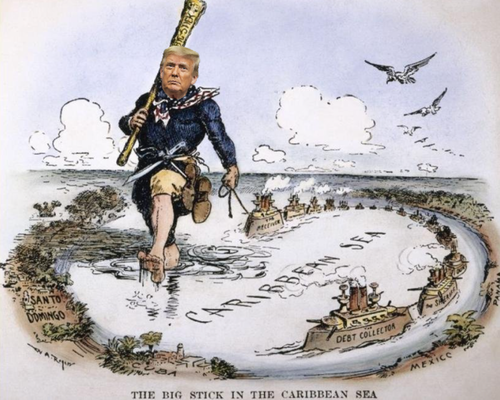
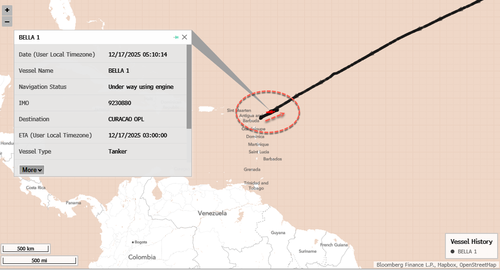
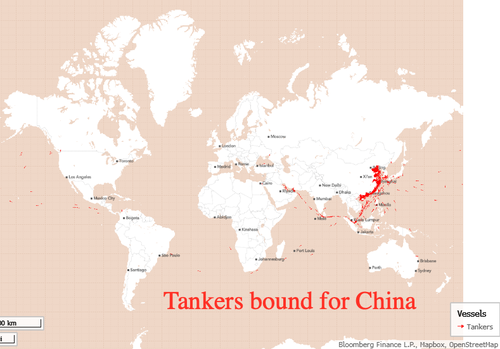
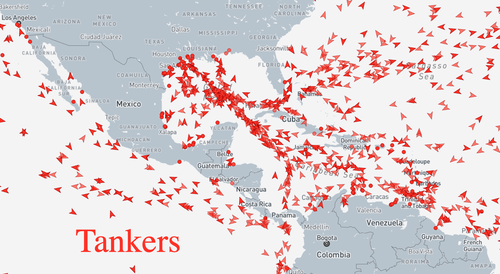


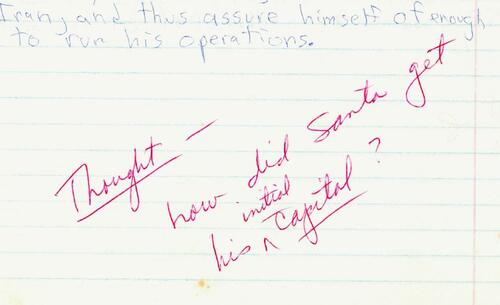
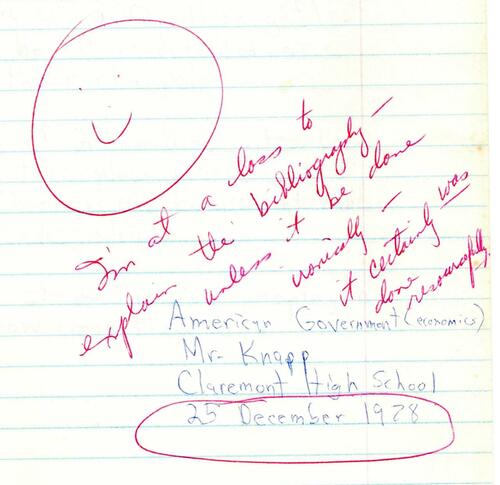



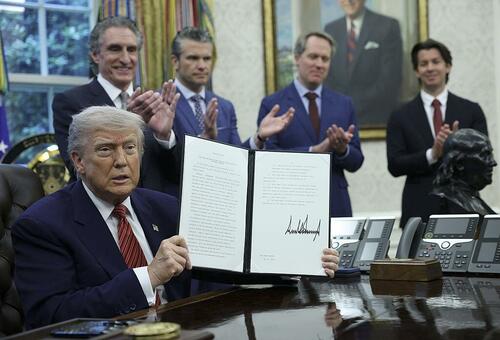
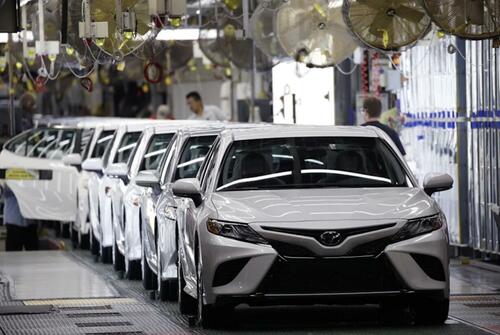



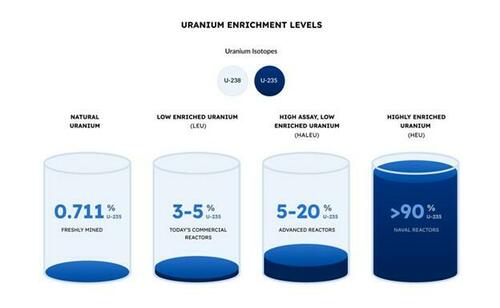




Recent comments